Sourdough English Muffin Recipe
This post may contain affiliate links.
Sourdough English muffins are such a lovely little invention. They are tangy rounds of fermented dough with just enough nooks and crannies to hide butter and jam in.
And they are actually quite easy to make - you just have to be organised to give the dough enough time to ferment. This recipe uses an active and bubbly sourdough starter, however there is a variation for Sourdough Discard English Muffins further down.
English Muffins made with sourdough starter are fairly easy to put together. You basically mix the dough into a relatively smooth (yet sticky) dough and then leave it overnight to ferment.
If you have a bit more time, you can pop it in the fridge to ferment for up to 3 days. This little trick will ensure you don't over ferment the dough ... and you get that beautiful rounded sourdough tang that is so sought after with sourdough English muffins.

English Muffins Aren't Really English
Here's some trivia for you ... because I just love a bit of history. English muffins aren't actually English. In fact, they were invented in the US. And in England - they're called American muffins. Crazy right?
These crazy popular leavened muffins were actually invented by an Englishman in the US, New York City to be precise. If you're interested in more of the history of English Muffins, you can read all the info here.
How To Make Sourdough English Muffins
This sourdough English muffin recipe is quite simple. The process does take a few days due to the fermentation - but this is a good thing because your sourdough starter will make English muffins that are much easier to digest than store bought ones!
Ideally, you'll need an active sourdough starter, but discard will work (see notes on this further down). You might also like to turn this into a sourdough English muffin loaf.

Here's the basic process for making English Muffins with a sourdough starter:
- Add flour, milk, honey, salt and sourdough starter to a large bowl and mix together to form a sticky dough.
- Use wet hands or a dough scraper to gently knead the dough in the bowl. It will be sticky because of the hydration level, but it will form a dough.
- Cover the bowl and leave it to ferment on the kitchen counter (overnight is ideal as long as it's not too warm). You'll find the mixture will double in size.
- Once the dough has fermented, work you way around the bowl and bring the dough into a ball using stretch and folds.
- Leave the dough to rest for around 30 minutes.
- Now sprinkle a generous amount of corn meal onto your kitchen counter and ease the dough out on top of this.
- Gently roll the dough out to form a rectangle (you can use your hands if you like).
- Use a scone or biscuit cutter to cut rounds of dough out. I used a small glass dipped in flour to stop it sticking.
- Place the rounds onto a parchment lined tray dusted with cornflour.
- Leave them to rise for around an hour (they should be puffy and light).
- Heat a skillet or frying pan and dust with corn meal.
- Place 4 English Muffins into the skillet at once and cover. Cook on medium heat for around 6 minutes before flipping them and cooking on the other side.
- Once they've cooled a little, split them and spread with butter and jam!
Stages of Fermentation for Sourdough English Muffins

This image shows the dough when it's first mixed to how it looks when you've pulled it together into a ball after fermentation.
You can see that the dough has developed structure and smoothed out.
The bottom left shows the dough turned out onto the kitchen counter. You can see the beautiful gluten strands that have formed during fermentation.
The dough is still a little sticky at this stage, so corn meal is essential to keep it workable and if you have some cornmeal leftover, why not try these sourdough cornbread muffins.
If you are loving fermented breakfast treats, you might also like these overnight sourdough waffles.
The Secret To Good Sourdough English Muffins
Whether you're making sourdough English Muffins, or the regular variety - there's one thing that can make or bread a good muffin. You can't cut them!
Seriously, do not use a knife. To make sure you get maximum nooks and crannies, you need to split them with a fork.

Once they're cool, push a fork into the side of the muffin and keep going around the edge until it splits open.
This is called "fork split" and will ensure that there are lots of "gnarly" bits of dough that go crispy and brown when toasted. Trust me, it's a game changer!
You must ensure that they have cooled though - if you do it when they're too hot, the steam trapped inside will cause a gummy crumb (just like when you cut sourdough bread too soon).
Patience really is a virtue with sourdough!
Additional Tips
I like to make my English Muffins with active, fed sourdough starter. But if you have lots of discard to use up, you can use the discard instead (as long as it's not too old, up to a week is ok).
If you want to use your discard in this recipe, just use it instead of active starter and add a half teaspoon of commercial yeast to your mixture.
This will ensure that the dough rises enough. This is especially important if you're still building your starter as your discard won't have enough of a yeast colony yet.
Still follow the instructions below, they will work.
You might just find that it rises a bit faster with the commercial yeast, so you won't need to leave them to rise for so long. They will also ferment in the fridge if you use commercial yeast.
If you have a mature starter, I would recommend trying this recipe without commercial yeast. Because of the long ferment time, you might be pleasantly surprised - even with your discard!
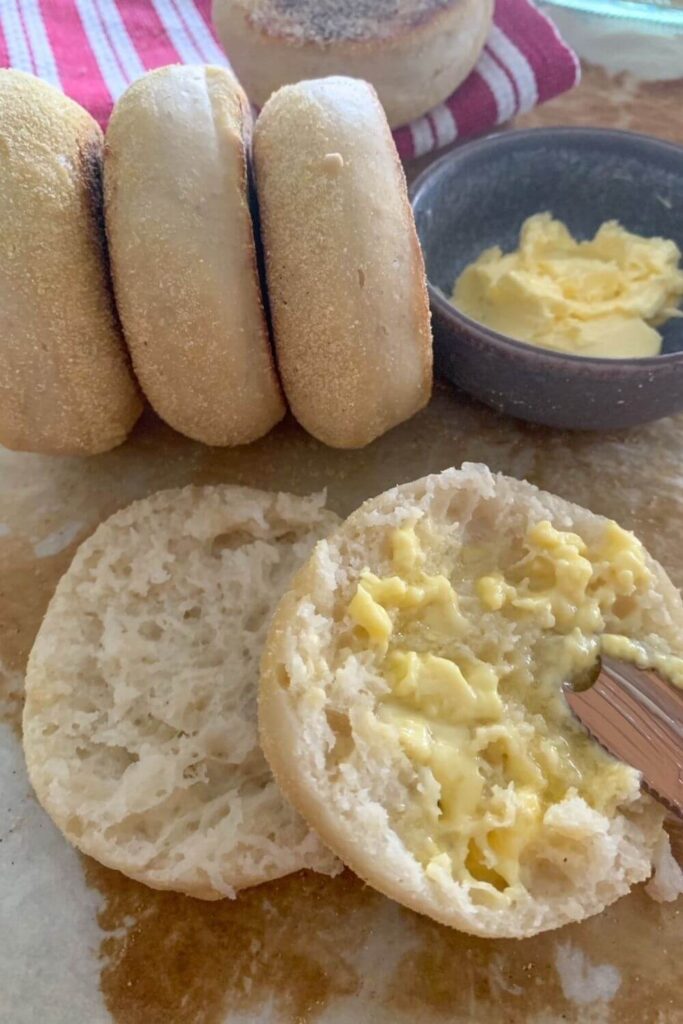
Making Sourdough English Muffins in Hot Weather
If the weather is warmer where you live, you might need to adjust things ever so slightly to ensure that you don't over ferment your dough.
It's not dissimilar to making traditional sourdough bread and making allowances for hotter temperatures.
Sourdough English Muffins are meant to be fermented for a longer period (it's what gives them the most amazing flavor), however if the ambient temperature in your home is over 28C you may need to use your refrigerator.
Once you've mixed the dough, allow it to ferment a little while on the kitchen counter - no more than an hour. Then place the dough into the fridge to ferment. It will take up to 3 days to fully ferment in the fridge.
If you do want to do an overnight ferment on the kitchen counter then you can reduce the amount of starter used. Drop it down to 100g of starter and use cold milk when you mix the dough.
These small tweaks will allow you to ferment the dough longer without over fermentation.
Serving Suggestions
There are lots of ways to enjoy these delicious sourdough English Muffins. While they are absolutely perfect toasted with lashings of butter, you might also enjoy some of these ideas:
- Toast and top with with homemade butter and sprinkle with cinnamon sugar. You might even like to serve them with this whipped honey cinnamon butter!
- Use them to make bacon and egg breakfast sandwiches. Don't forget the cheese! I love using this sourdough scrambled egg inside mine!
- Use them instead of burger buns for something different.
- Top with your favorite slices of cheese, fresh tomato and lashings of salt and pepper. This might just be one of my favorite lunches.
- Use them as mini pizza bases. My boys love making their own pizzas after school and these sourdough English muffins make it a breeze!
Notes & Substitutions
A few notes on ingredients and substitutions for sourdough English Muffins:
- You can use plain or all purpose flour instead of Bread or Baker's flour if you want to. But you may find that you need to reduce the amount of milk.
- If you have buttermilk on hand from making cultured butter or sweet cream butter, you can substitute some of the milk in this recipe with the buttermilk.
- You can use plain or all purpose flour to dust them with instead of corn meal, however you won't get the same cooked texture as you would with corn meal. Semolina is a better substitute than corn meal.
- You can keep the mixture for this sourdough English muffin recipe in the fridge for up to 3 days. Take it out of the fridge for around 30 minutes before you turn the dough out on the kitchen counter. Cut the rounds out and then let them rise before you cook them. It's better to cut them out with cooler dough and then let them warm up.
- Once you've cut them out, you can put the tray in the fridge for up to 24 hours. Let them come back to room temp before you cook them.
- Cooked English Muffins freeze really well. Store in ziploc bags and defrost and toast as you would like. For easy toasting, don't forget to fork split them before you freeze them.
If you're looking for another English inspired sourdough recipe, check out these sourdough crumpets.

Want More Recipes?
If you love this recipe, you might be interested in these ideas:
- Easy Sourdough Bagels
- Sourdough Hamburger Buns
- No Wait Sourdough Waffles
- Lemon Sourdough Muffins
- Apple & Cinnamon Sourdough Muffins

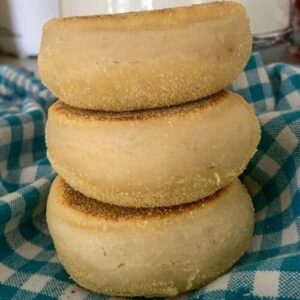
Sourdough English Muffins
Video
Equipment
- Mixing Bowl
- Cast Iron Skillet
- Biscuit Cutter
Ingredients
- 200 g Sourdough Starter fed and bubbly (reduce in warmer weather)
- 500 g Milk cold is better for overnight ferment
- 600 g Bread Flour
- 12 g Salt
- 20 g Honey you can use sugar if you want to
- 50 g Cornmeal for dusting
Instructions
- In a large glass bowl, mix together all of the ingredients, including your sourdough starter and bring it together to form a dough. The dough will be quite sticky. Gently knead the dough to bring it together.It's easy to do by hand in the bowl for less washing up, but if you prefer to do it in a stand mixer that's perfectly fine too.

- Once you have a dough formed, cover it in plastic wrap and set aside for around 12 hours to ferment at room temperature (see notes). You want the dough to rise (it doesn't need to double though). It should rise at least half in the bowl and become a smoother, structured dough (see the pics above of my dough). It's important that the dough maintains its gluten structure in order to be shaped into rounds.Just like traditional sourdough bread, you'll need to watch the dough, rather than the clock.

- Once you're happy with the dough, you can wet your hands and gently shape your dough into a rough ball by performing a set of stretch and folds. This will deflate the dough - but don't worry. Now leave the dough to rest for around 30 minutes.
- Dust your work surface with corn meal and then ease the dough out of the bowl. Sprinkle corn meal on the top of the dough too. Depending on how sticky your dough is, you might need to add some extra as you go along so keep it handy.

- Gently press the dough into a rectangle using your hands. Using a rolling pin, gently roll your dough to around ½ - ¾ inch thick. You don't want it too thick or your muffins will be doughy and take too long to cook in the middle. Using a biscuit cutter (or glass or plastic tumbler) gently cut out rounds of your dough and place them on a baking sheet lined with parchment paper and dusted with corn meal. Keep going until you can't cut any more. Then gather up the dough, roll it back out and repeat until you've used all the dough up.Cover the muffins with a tea towel and leave to rest for around 30 minutes.

- Heat a fry pan or skillet on the stove top. You want a medium heat - you don't want to burn the outside and leave the inside raw, so just keep an eye on them and adjust as you need to. Place 4 - 6 muffins in your skillet, cover with the lid and cook for around 6 minutes on each side. There is no need for oil or butter, the corn meal will protect them from sticking. Turn them over once you see the dough bubbling (they will be puffed up from the heat).Once they are golden on each side, take off the heat and allow to cool. Repeat the process until all of the muffins are cooked.

- Once they are cool, use a fork to split them and enjoy them with butter or toast them for extra golden goodness!

Notes
Nutrition


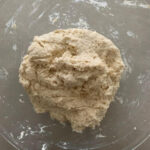
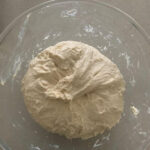
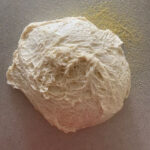
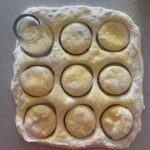
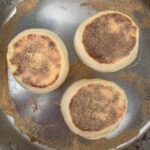
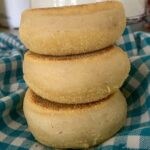

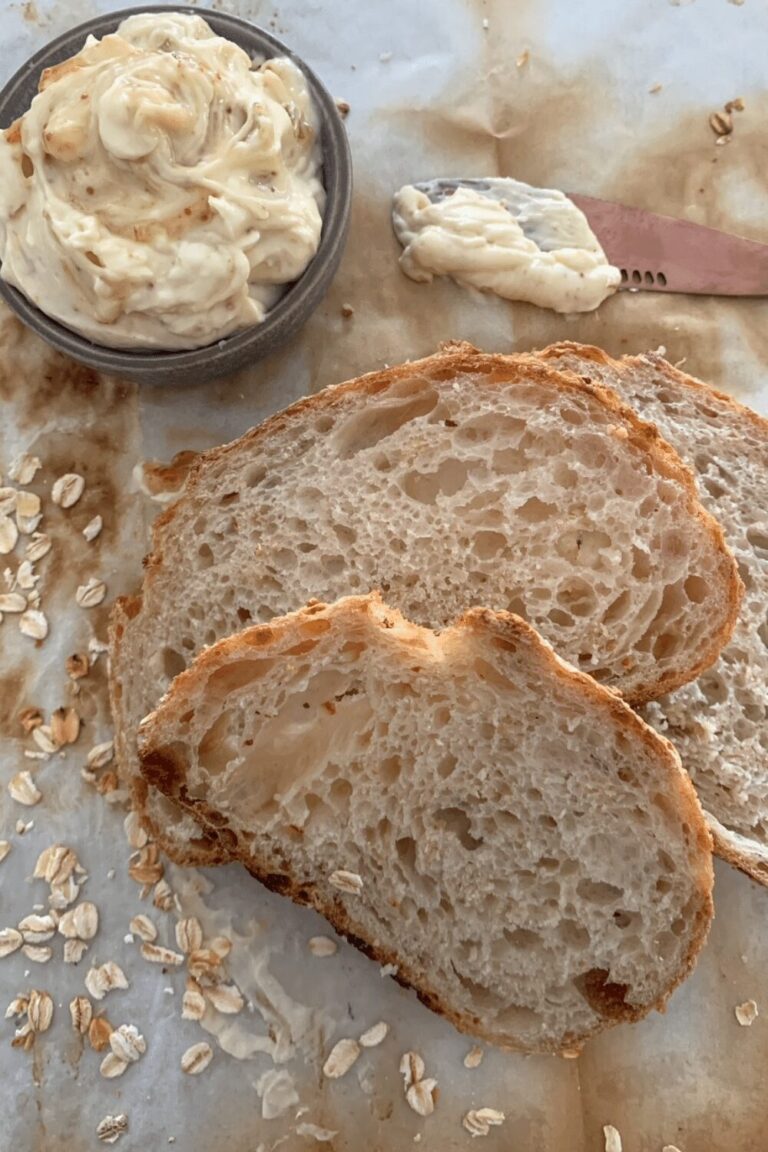
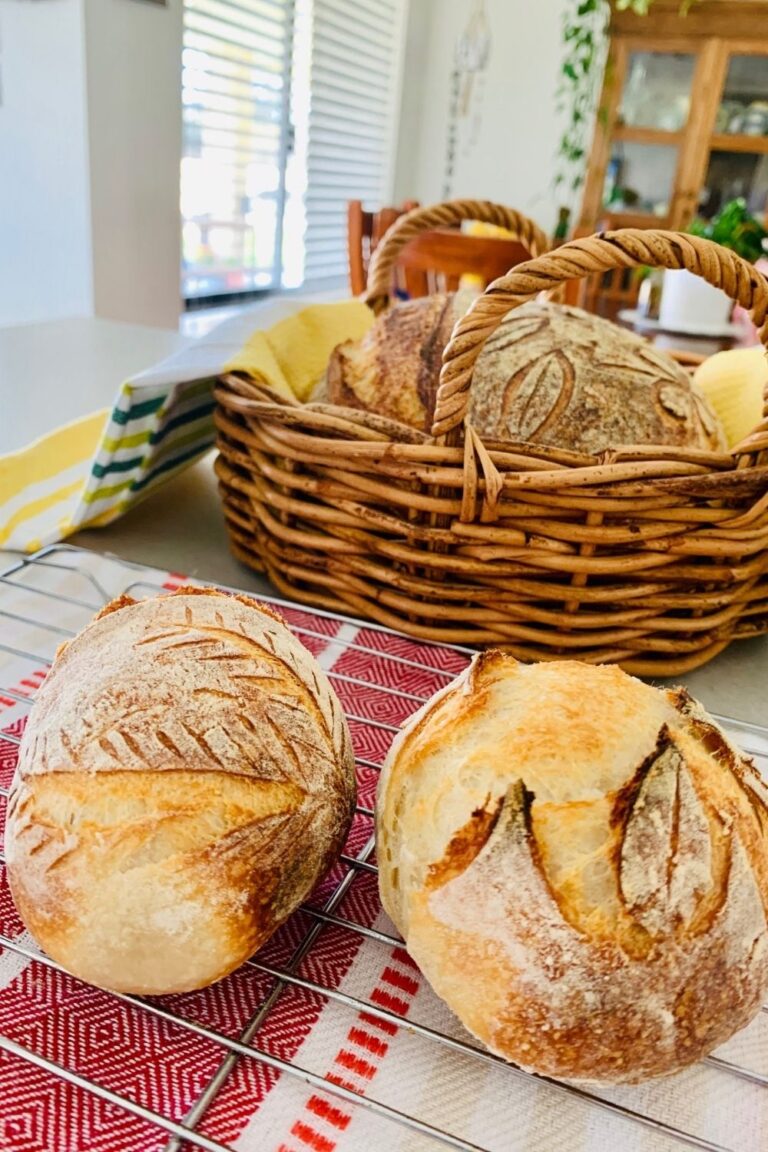
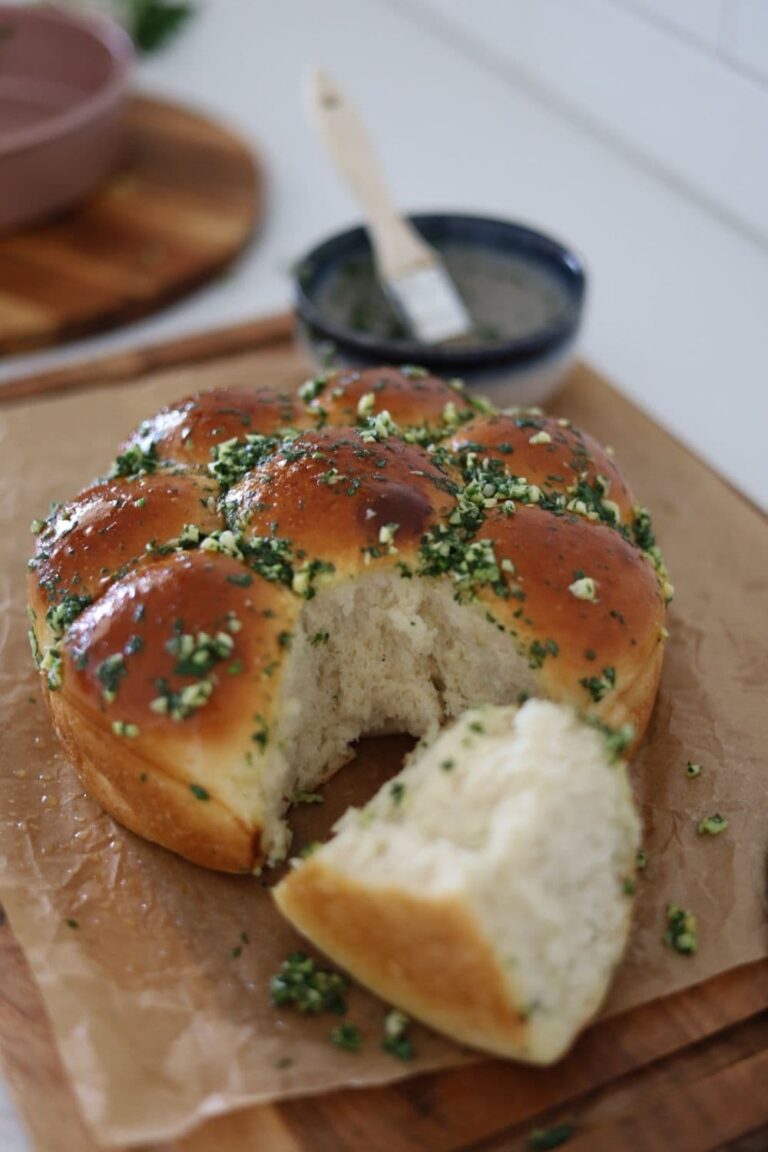

Can I use almond milk or oat milk instead of the milk?I would love to make these, We are dairy free
You can! Either will work. Almond milk may be a bit better, but the oat milk should work too.
Has anyone substituted almond milk for this recipe?
That should work, Sara.
I made this recipe with overnight fermentation.
This is amazing .
I made a few changes within the confines.
Used 240 Bread flour
40 sorghum
20 coconut
And 20 Allaluse instead of honey. Still perfect and delicious.
Thanks a lot for sharing this recipe
Looking forward to trying your recipes.
Incredible easy and delicious recipe! Thank you!!
I must be doing something wrong because every time I make this, my dough is more like thick pancake batter. Help! It’s almost equal amounts of liquid and flour. Is this correct?
The dough is wet, but should still be workable ... are you using bread flour?
Hi, I'm definitely missing something, because on this 4th attempt, I find that with the amounts and proportions given, I end up with a sticky, unmanageable need that needs almost an extra cup of flower or some hard refrigeration. I do end up with a palatable and delicious result, but I'm not sure if it's the fact that I'm not using high protein flour. That's my go to next time.
Hi,
Just a small point in England we do not call these muffins American muffins. We just call them muffins.
To us American muffins are the ones like giant cup cakes.
In the printed recipe, step 5, it says to leave for rest for around 30 minutes and online in the directions above the recipe, step 10, it says to wait for about an hour. What am I looking for? Just trying this recipe for the first time and just curious. I acknowledge with sourdough looking at the dough is better than timing. The online step 10 says they should be puffy and light. Should I just look for this and not the time?
Thanks for letting us know! Yes, keep an eye on it and go by the look as opposed to time. 🙂
Absolutely the best recipe! Thank you for sharing. Followed the recipe and all we had to adjust was cook time. (My pan heats high.) I was hoping to be able to put some up for the school year, family devoured them. We are making another batch . I recommend trying this recipe. Thanks again for sharing.
Have you made these with fresh milled flour? If so, do I need to do anything differently?
I'm sorry I haven't tried them with freshly milled flour.
I found the dough fairly sloppy, when I mixed it. Does it become "stiffer" after fermentation, or should I add more flour now?
It should strengthen up as it ferments, yes 🙂
Made these for the first time today. Wow! They turned out beautifully. I'm just beginning my sourdough journey (about a month into it), and your recipes and tips have been very helpful. Thank you!!
Hello!!! I love all your recipes!! For this English muffin recipe, I wanted to make a cinnamon raisin version. When should I add the cinnamon and raisins and how much would you recommend?
I recommend this sourdough cinnamon raisin English muffins recipe 🙂
I've made these several times with unbleached flour, but I was wondering if I could use emmer or spelt instead and if so, would I have to add more milk?
Would it be possible to use an non-dairy milk and have the same result? Oat milk, for example?
Yes, that should work! 🙂
Question- if when cutting the muffins out they begin to fold in on themselves. Does this mean the dough is rolled too thin?
Trying to find the perfect thickness as to not have them too thin to really make a sandwich but not too thick that they don’t bake.
My dough keeps ending up very sticky and soupy! Won’t keep its form. The same happened for me with the regular sourdough loaf. I live in Minnesota so I’m not sure if I need to adjust something? This last time I tried adding about 1/2 cup extra flour, but still the same. It’s very discouraging! Any ideas??
Hi Hannah, There are many different reasons for wet dough. This post on Why is my Sourdough Wet & Sticky goes through a bunch of troubleshooting that should help.
My dough kept growing! 😂 I had to knock it down a couple of times and split it between two bowls for the cold ferment. If I'd realized the recipe makes 24 I would have cut it down. But now that I've tried one... Wow!! I am so glad I will have so many! I'm planning to perforate them all with the fork and then freeze. Should I completely split them prior to freezing?
Very good directions and details. I live in the US and had to convert everything to cups and ounces, which I double-checked each time with an online converter. However, the amount of milk called for made it way too moist, so I had to add much more flour than in the recipe, probably doubling it. After that, I let it rise on the countertop for about 8 hours, when it was popping over the top of the glass bowl and touching the plastic wrap. It was very gooey and I had to flour the board quite a bit to work with it, then I added the cornmeal as instructed. After that they cooked up great, particularly by using the cover on the skillet. Thank you!
Thank you for sharing, Sharon. I'm so glad you were able to make it work. We typically recommend weighing ingredients since it's a bit more accurate and the weight of flours can vary. It sounds like you were able to make it work out, but here's a breakdown on why we recommend weighing ingredients if you're interested. 🙂
These are so yummy, next time I'd like to try adding fruit and cinnamon but can't see anywhere in the notes or comments if this is a good idea?
In step 3, the recipe states: "Once you're happy with the dough, you can wet your hands and gently shape your dough into a rough ball by performing a set of stretch and folds. This will deflate the dough - but don't worry." How many S&Fs do you recommend?
You can just do one set (so 4 stretch and folds).
Hi - Would you make any changes to this english muffin recipe for high altitude 9330 ft? Thank you!
Hi Kim, There are a few tips/changes we recommend when baking sourdough recipes at a high altitude. These high altitude sourdough baking tips should help.
Can you substitute a plant milk for dairy milk?
That should work, Regina. 🙂
Can these be made into Individual balls rather than cut out with a round ring?
With your english muffin recipe can the muffins be shaped into balls that will then flatten rather than rolling out dough and cutting with a circular ring? If so what weight would you recommend piecing the dough balls out to?
Thanks in advance
You would need to decrease the hydration of the dough to achieve this as this is quite a wet dough, hence why cutting them out is much easier 🙂
Can I use corn flour if i don't have corn meal?
No, corn flour won't work (that's the same as corn starch). It needs to be cornmeal, which is more like polenta in texture 🙂
I just found you! Your instructions are so clear and you have great explanations and reasoning that I can apply to other recipes as well. You’re my new go-to for everything sourdough. ❤️
Thank you, Susanna! We LOVE to hear that!
My english muffin dough is too wet. What can I do?
Corn meal is the secret here, it helps you to be able to cut out dough that is really sticky and create light and airy English muffins with lots of nooks and crannies.
I just made these for the first time yesterday and they came out perfect! My starter was about 8 hours from peak but it is very active and did great. Thank you!